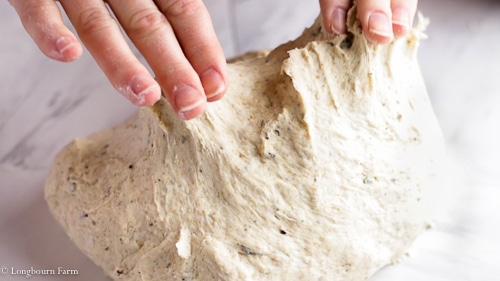Do you know the different types of baker's yeast and when to use them? Read this post to know exactly what type of yeast you should use and when!

There are so many different types of yeast, and each serves its own purpose. Knowing the difference between baker’s yeast, instant yeast, and fresh yeast can help you out when you are baking, especially with bread and things that can be a little temperamental.
What are the different types of yeast?
- Active Dry Yeast
- Instant Yeast
- Rapid Rise Yeast or Bread Machine Yeast
- Fresh Yeast

Active Dry Yeast
This is “normal” yeast. You’ll most likely be familiar with finding this yeast in a strip of foil packets, all held together at the seam. This yeast can be bloomed in water to jump-start activation. It also needs 2 rise steps in a recipe.
Instant Yeast
This yeast is specially formulated to activate more quickly. This yeast does not need to be bloomed in water and can tolerate just one rise step in a recipe. It can also be found in little pre-portioned packages.

Rapid Rise Yeast or Bread Machine Yeast
Both of these yeasts are similar to Instant Yeast. The granules are usually smaller and more round to work better in bread machines. These two different types of yeast can be used interchangeably in recipes.
Fresh Yeast
This is a wet, compressed yeast that is ideal for many baking applications. It is not very common because it is not shelf-stable. It can be used in all recipes that call for dry yeast. You’ll find it sold in the refrigerated section of the grocery store.
Looking for some great yeast bread recipes?
- Bread Recipe
- Honey Wheat Rolls
- Cinnamon Roll Recipe
- Homemade Pretzels
- Sticky Buns
- Homemade Wheat Bread
- Dutch Oven Bread
- Easy Pizza Dough
- Homemade Foccacia Bread
- Herb Bread
- Soft Pretzel Bites
- Orange Rolls
- Skeleton Rolls
- Dinner Rolls
- Pumpkin Cinnamon Rolls
- Garlic Knots
- Garlic Cheese Bread
- Cinnamon Twists

Converting yeast measurements
With there being so many different types of yeast, the measurements required often vary. Recipes requiring yeast often ask for a larger measure of dry yeast than they do fresh yeasts.
- A single packet of dry yeast is already measured in the most common measurement requested from recipes.
- 1 packet of dry yeast = 2 ¼ teaspoons of dry yeast = 2 ounces fresh yeast
When you get to know the different types of yeast, you can see for yourself just how different and unique they can be.






Pam
How to store the instant yeast? I have read the active yeast should go to the fridge, does it apply the same to instant yeast? Is it better to put it on a glass jar? Thank you.
Alli
Hi Pam, yes you can store instant yeast in a jar in the fridge. I also freeze mine for long term storage. I usually just store mine in plastic containers, I haven't noticed any issues using plastic vs. glass.
Beverly
If I have instant yeast in a 1 pound pack and my recipe calls for 1 packet of yeast do I use the same measurement as the regular dry yeast? 2 1/4 tsp = 1 packet?
Alli
Yes, unless you're using fresh yeast the measurements of 1 packet of yeast will equal 2 1/4 teaspoons.